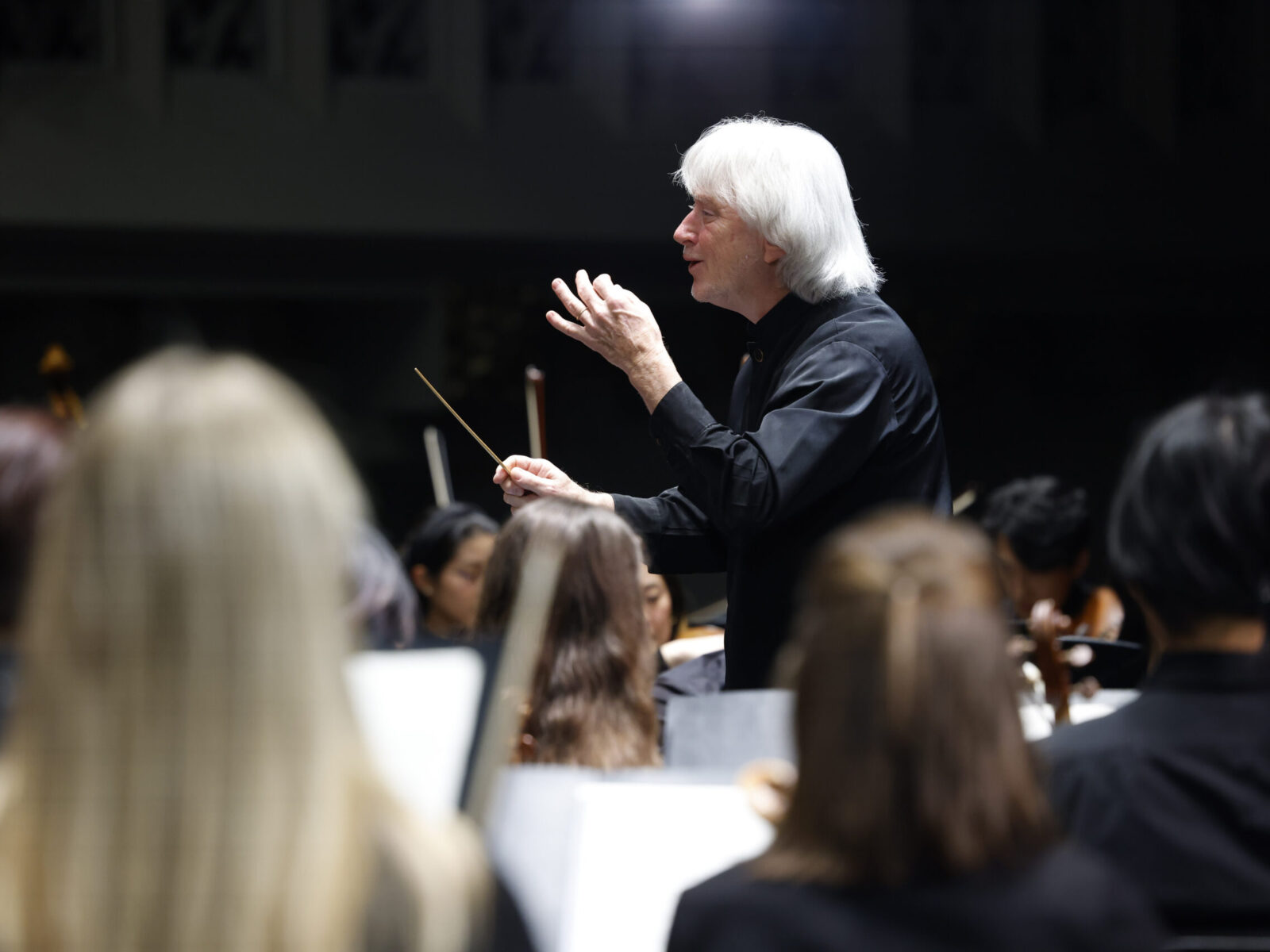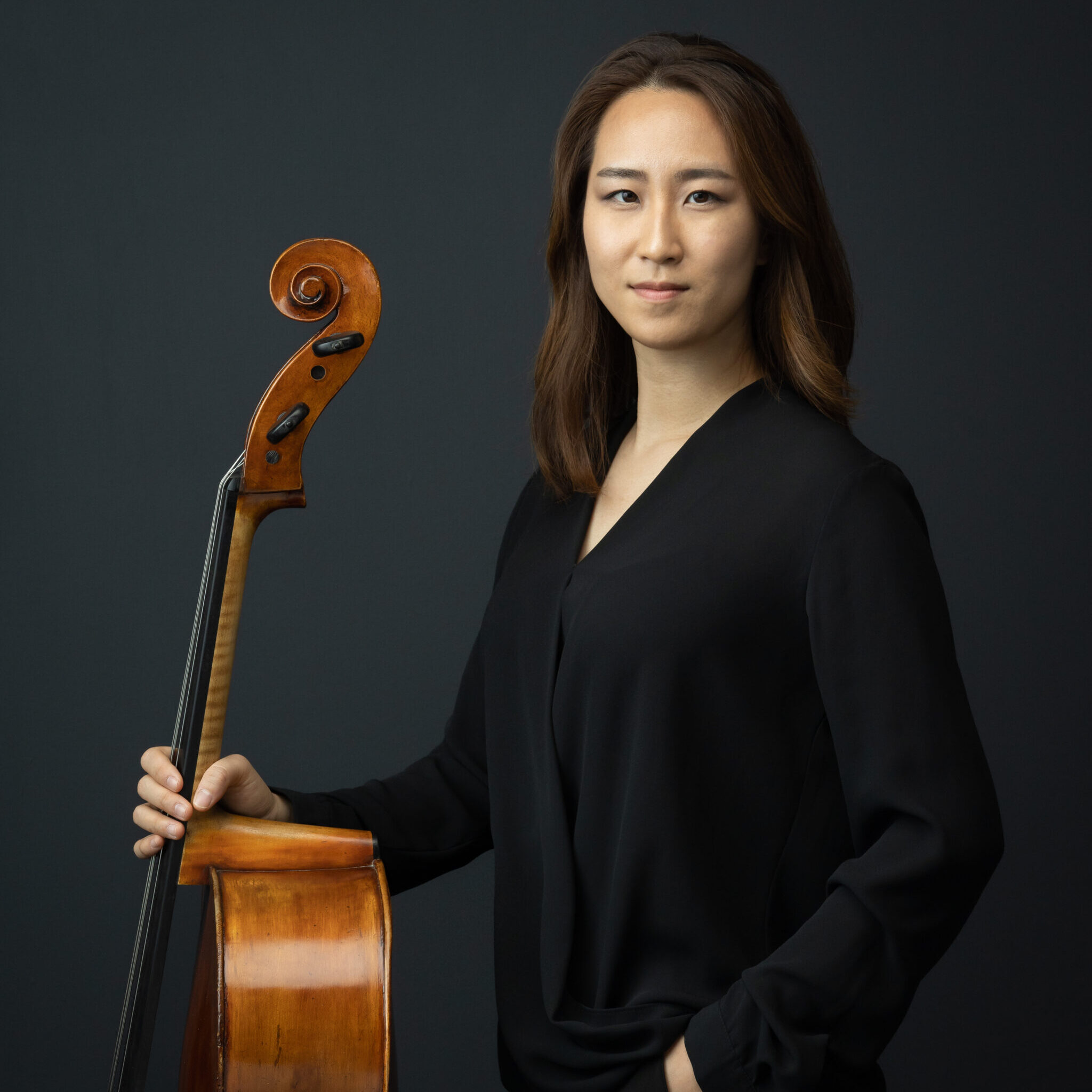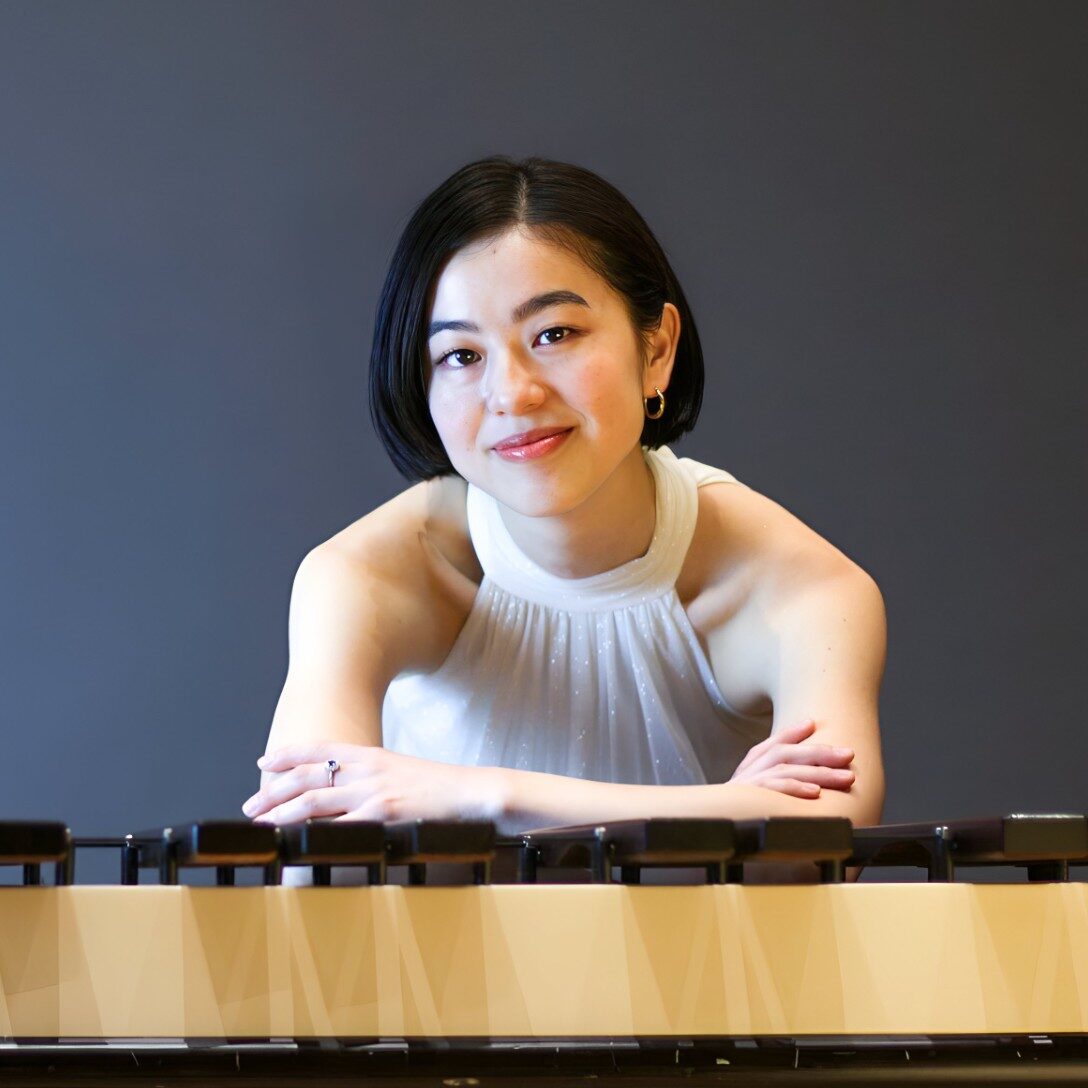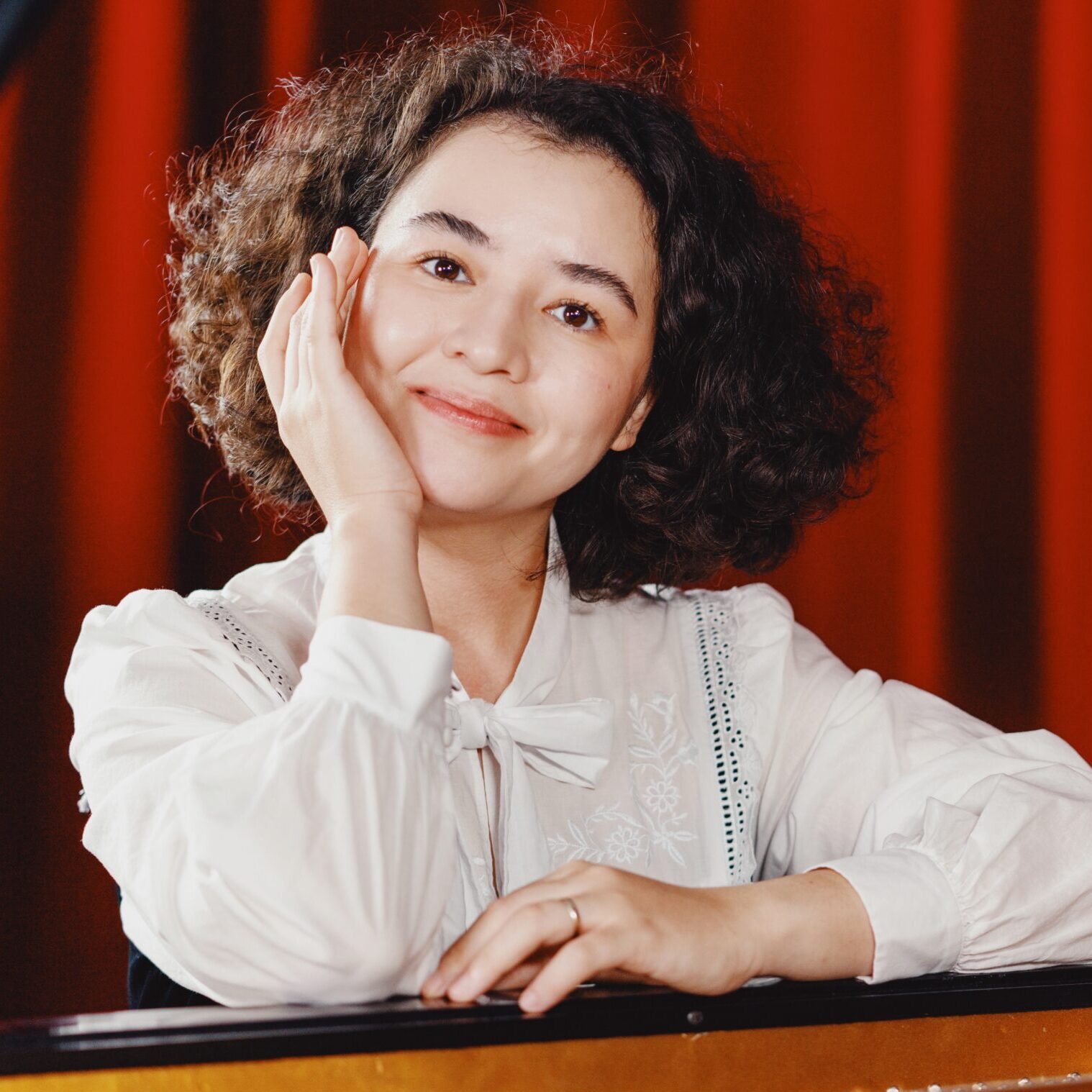
Concert Programs
USC Thornton Symphony Concerto Night concert program
Carl St.Clair, principal conductor of the USC Thornton Symphony, leads the orchestra in Robert Schumann’s Cello Concerto in A Minor, Op. 129, Kevin Puts’ Marimba Concerto and Sergei Prokofiev’s Piano Concerto No. 3 in C major, Op. 26.
The concert features cellist Ji Sun Jung, marimba player Kana Funayama and pianist Evangeliya Delizonas-Khukhua.

Program
Cello Concert in A Minor, op. 129 (1850)
I. Nicht zu schnell
II. Langsam
III. Sehr lebhaft
Ji Sun Jung, cello
Robert Schumann
(1810-1856)
Marimba Concerto (1997)
I. Flowing
II. Broad and Deliberate
III. With Energy
Kana Funayama, marimba
Kevin Puts
(b. 1972)
Piano Concerto No. 3 in C Major, op. 26 (1921)
I. Andante – Allegro
II. Andantino
III. Allegro ma non troppo
Sergei Prokofiev
(1891-1953)
Program Notes
Cello Concerto in A Minor, op. 129
Robert Schumann
Robert Schumann composed his Cello Concerto in A Minor in 1850, during a turbulent time in his life shortly after moving to Düsseldorf to become municipal music director. He had begun experiencing increasing depression that strained his relationship with Clara, his wife. This dark period marked the onset of Schumann’s mental decline, which surged his creative output and inspiration for the writing of this concerto. The work was written in just two weeks but remained unperformed during his lifetime, with its premiere occurring posthumously in 1860.
Unlike many virtuosic classical works of this era, Schumann focussed mainly on lyrical intimacy with his Cello Concerto. As in many of his compositions, the movements of this concerto flow directly into one another without breaks. The first movement, “Nicht zu schnell,” opens with a somber orchestral introduction before the cello comes in with a melancholic, yet expressive theme. The second movement, “Langsam,” resembles a German Lied, evoking a strong sense of nostalgia. Schumann also introduces a unique feature with having the solo cello’s melody mirrored by another solo cello part within the orchestra. The final movement, “Sehr lebhaft,” closes everything with a lively and playful energy, though it never lets go of the work’s overall introspective tone.
Overall, it seems Schumann sought to immerse himself in the exchange of sonorities between the soloist and orchestra in this work. In line with his vision of this concerto, he described it as “a mannerly battle between the solo and the separate orchestral voices.” This makes it a particularly beloved work among cellists and remains as one of the cornerstones of the cello repertoire.
–Abby Park (BM ’26)
Marimba Concerto
Kevin Puts
Marimba Concerto (1997) emerged from my close collaboration with marimbist Makoto Nakura, for whom I also composed several solo and chamber works in the Nineties while still a graduate student at the Eastman School of Music. In recent years, rising star Ji Su Jung has championed the concerto and eagerly expressed an interest in recording it. Commissioned by Nakura and the Vermont Symphony Orchestra for a tour around the orchestra’s home state, the concerto’s opening melody was probably inspired by my hearing a pianist warming up on the stage of the Eastman Theater as I passed through it on the way to a class. The harmonic progression he played – a series of chords whose bass line descended by step while the upper notes outlined simple triads – struck me as poignant in its simplicity. I have always felt close to the key of E flat, due its rich qualities and probably also to the many works of Mozart written in this key, in particular two of his piano concertos that served, in many ways, as a model for this concerto. The first movement spins forth from this melody as the marimba embellishes it virtuosically. The second movement, cast in more elegaic hues than the first, employs only the string section of the orchestra, which introduces reflective four-voiced textures that are eventually taken up by the solo marimba. The third movement, an athletic moto perpetuo for the marimbist, gradually recalls the elements of the first movement’s melody, culminating in a reprise of this melody within the context of this final movement’s more dance-like nature.
–Kevin Puts
Piano Concerto No. 3 in C Major, op. 26
Sergei Prokofiev
Sergei Prokofiev completed his third piano concerto in the summer of 1921, and premiered the piece himself in December of that year with the Chicago Symphony Orchestra. The piece had been in the works for as long as ten years before Prokofiev finally committed to finishing the project, while spending a summer in Brittany.
Like his other works for piano, this third concerto was an opportunity for Prokofiev to showcase his prowess as both a composer and a pianist. Throughout his musical education, the two went hand in hand. Throughout his youth, he took lessons in piano and composition, and had already written an opera by the age of 10. While he studied at the Saint Petersburg Conservatory, Prokofiev continued taking classes in piano performance and elements of composition. The two came together in his final exams at the conservatory, for which he performed his first piano concerto.
Prokofiev’s virtuosity as a performer, in addition to his composition skills, gave him the opportunity to leave Russia during the Russian Revolution. Prokofiev supported the movement, but according to him, his country “had no use for music at the moment.” So, he took his talents to the United States, where he toured as a concert pianist. The Chicago premiere of Piano Concerto No. 3 was part of this tour, and it was a wild success. According to Chicago’s Daily Herald, it was “the most beautiful modern concerto for piano.” This success kicked off the concerto’s popularity, and it is now the most played of his five piano concertos.
The first movement of this beloved concerto establishes the orchestra’s role as an equal participant in the music. The piece begins with two clarinets, followed by a whirlwind of strings that sets up the energetic piano entrance. Throughout the movement, the focus bounces between the piano and various sections of the orchestra. The second movement takes on the structure of a theme and variations, where influence from Haydn and Mozart can be heard. The theme is introduced by the flute, followed by the clarinet. Finally, the third movement begins with quiet, staccato bassoons and low strings, which is abruptly interrupted by the piano’s entrance. This introduction is a perfect example of what Prokofiev describes as the “argument” that happens between the orchestra and the piano in this movement. The craziness eventually culminates in a grand ascension to a fittingly raucous ending, concluding Prokofiev’s dazzling concerto.
–Sean Cooney (BM ’24)
About the Artists
 Ji Sun Jung
Ji Sun Jung
Ji Sun Jung, a native of South Korea, is a distinguished Korean-American cellist active as a soloist, chamber musician, and orchestra member. She regularly performs with the Long Beach Symphony Orchestra as a section cellist and frequently substitutes with the LA Philharmonic, Pacific Symphony Orchestra, and LA Chamber Orchestra, having won the USC-LACO Mock Audition. Currently, Ji Sun serves as the principal cellist of the USC Symphony Orchestra, and she has previously held the same position with the Tanglewood Music Center Orchestra, Bob Cole Conservatory Symphony Orchestra, and Colburn Chamber Orchestra.
In recent years, Ji Sun has been recognized as a fellowship recipient at the Norfolk Chamber Music Festival (Summer 2024) and the Tanglewood Music Festival (Summer 2023). She has collaborated with numerous world-renowned musicians, including the Parker Quartet, Brentano Quartet, Dover Quartet, Pacifica Quartet, Peter Oundjian, Boris Berman, Daniel Phillips, Stephen Taylor, Yura Lee, and Tai Murray. At the Tanglewood Music Center, she performed under the batons of Dima Slobodeniouk, Xian Zhang, Andris Nelsons, Dame Jane Glover, and Susanna Mälkki.
As a soloist, Ji Sun has won numerous competitions, including the recent USC Thornton School of Music Concerto Competition, where she will perform with the USC Thornton Symphony in October 2024. Her other accomplishments include winning the Bob Cole Conservatory of Music Concerto Competition, performing with the Bob Cole Conservatory Orchestra, securing 1st place at the Pasadena Showcase House of the Arts Competition, and 2nd place at the Brentwood Westwood Symphony Orchestra Competition. She has also participated in masterclasses with renowned cellists such as Sheku Kanneh-Mason, Steven Isserlis, Seth Parker Woods, and David Requiro.
Ji Sun began playing the cello at the age of 11. She attended Sun-Hwa Arts Middle School and Seoul Arts High School in South Korea. After moving to the United States, she studied with Ronald Leonard and Clive Greensmith at the Colburn Academy. Ji Sun earned her Bachelor’s degree in Cello Performance from the Bob Cole Conservatory of Music at CSU-Long Beach under the tutelage of David Garrett. She completed her Master’s degree in Cello Performance at the University of Southern California with Andrew Shulman and is currently pursuing a Graduate Certificate in Cello Performance with Ralph Kirshbaum, beginning in Fall 2023.
 Kana Funayama
Kana Funayama
Kana Funayama is a Japanese percussionist, marimbist, and arranger whose performance career sees her in a wide range of engagements as soloist, ensemble player, and collaborative artist.
As a soloist, Funayama has presented solo recitals in major venues and media both in the US and Japan including in Tokyo, Sendai in Japan, Rochester, New York, Los Angeles, Seattle, Classical KING FM, and more. She has been featured as a soloist at numerous concerts including at La Folle Journée TOKYO, “Geisai” in Tokyo, Chosen Vale International Percussion Seminar, Eastman Percussion Ensemble, and many more. Funayama has performed concertos with the Sendai Philharmonic Orchestra in Japan, Walla Walla Symphony in Washington, and Whittier Regional Symphony in California.
As an ensemble player, Funayama has performed with the Los Angeles Chamber Orchestra, the Orchestra of the Royal Opera House, Tokyo Geidai Philharmonia, Tokyo Film Brass Orchestra, and many more. She was a member of a new music ensemble the Musica Nova Ensemble under the direction of conductor Brad Lubman from 2021-2023. As a member of the Eastman Percussion Ensemble, she was a featured performer at PASIC 2022 and a winner of the 2022 Percussive Arts Society Percussion Ensemble Competition.
Funayama is an active collaborator with instrumentalists and composers, appearing in collaborators’ recitals, album recordings, films, and premiere performances. She has been involved in premiering a wide repertoire of works including by award winning composer Billy Childs. She actively runs commission projects with composers and is dedicated to expanding and diversifying marimba repertoire in a variety of music styles and genres, leading to the promotion and popularization of the instrument.
As an educator, Funayama coached the Chamber Percussion Ensemble at Eastman School of Music from 2021-2023, and was invited to present at Eastman Online Percussion Festival 2021 as a guest artist. She has visited over 30 schools all over Japan including Fukushima, Kumamoto, and Tokyo to perform and teach younger percussionists in private lessons and band coaching. She has given percussion classes at USC Thornton School of Music and Colburn School.
Funayama holds her Bachelor of Music from Tokyo University of the Arts, and her Master of Music from Eastman School of Music with the esteemed Performance Certificate and Milton Schlesinger Percussion Prize. She is a candidate for Artist Diploma at USC Thornton School of Music.
 Evangeliya Delizonas-Khukhua
Evangeliya Delizonas-Khukhua
Born in a family of musicians in 1992, Evangeliya discovered the piano at the early age of three. She gave her first concert with Moscow Chamber Orchestra when she was five. In 1998, she entered a prestigious school for gifted children – the Moscow Central Music School of the Moscow State Tchaikovsky Conservatory as a student of Professor Tamara Koloss.
Since 2010 she has studied at the Moscow State Tchaikovsky Conservatory with Professor Ludmila Roshchina, where she has finished her Bachelor’s and Master’s Degrees in Piano Performance. In 2017 she earned her two-year postgraduate degree which is equivalent to an American Doctor in Arts. After that, she got a Full Tuition Scholarship at the International Center for Music at Park University, Missouri, and in 2020 pursued Artist Diploma in Piano Performance under Van Cliburn Gold Medalist Professor Stanislav Ioudenitch.
In 2021 Evangeliya was admitted to the USC Thornton School of Music to pursue a Doctor of Musical Arts in Piano Performance as a student of Professor Stewart Gordon. Since 2022 she has been a Graduate Teaching Assistant at the USC Thornton School of Music. Since 2024 she is a Char of the Thornton School of Music Student Council.
She is the 1st Prize Winner of the USC Concerto Competition in Los Angeles in 2024, 1st Prize Winner of the Les Grandes Concours Internationales D’été in Los Angeles in 2023, 3rd Prize Winner of the Sixth NTD International Piano Competition in New York in 2022. She performed in Carnegie Weil Recital Hall in New York (2024), Soka Performing Arts Center in California (2023), Kaufman Music Center Merkin Hall in New York (2022), Baruch Performing Arts Center in New York (2019), Historical Raymond Theatre in Washington (2019), Zipper Hall of the Colburn School in Los Angeles (2018).
Evangeliya has been employed as a Collaborative Pianist at the Moscow State Bolshoi Ballet Academy of Choreography and as an accompanist at the Vocal Department of the Moscow State Tchaikovsky Conservatory.
She is a constant stage partner to her husband – Igor Khukhua, a violinist with worldwide recognition and an artist of the Jacksonville Symphony Orchestra.
She speaks Russian (native) and is fluent in English, German, and Greek. Her background is rich in diverse cultural heritage, encompassing Greek, Korean, and Russian roots.
Acknowledgements
USC Thornton Large Ensembles
Carl St.Clair, principal conductor & artistic leader
Sharon Lavery, resident conductor
Mike Basak, classical large ensembles manager
Brent Anderson, head librarian
Sara Petty, USC Thornton Winds teaching assistant
Office Staff
Sean Cooney
Sylvia Ettinger
Kaitlin Miller
Abby Park
Marcos Rivera
Avery Robinson
Reese Romero
Maia Ruiz-Law
Marcos Salgado
Evelyn Webber
Lilian Young
Ensemble
VIOLIN I
Yifei Mo, concertmaster
Veronika Manchur
Marena Miki
Diana Dawydchak
Ayman Ishmael Amerin
Yiran Yao
Beau Henson
Sara Yamada
Abigail Park
Ashlee Sung
Chloe Hong
VIOLIN II
Bradley Adam Bascon, principal
Kaiyuan Wu
Dahae Shin
Laura Gamboa
Agatha Blevin
Maya Irizarry Lambright
Ariana O’Connell
Dominic Guevara
Junha Park
VIOLA
Sunwoo Lee, principal
Katherine Brown
Matthew Pakola
Ziyan Zeng
Nicolas Valencia
Prosper Luchart
Jasmine Maldonado
Yu-Chen Yang
CELLO
Olivia Cho, principal
Mingchen Ma
Taewon Park
Samuel Leonard
Ernest Carbajal
Yongjoon Choe
Samuel Guevara
Elaina Spiro
BASS
Eric Windmeier, principal
Jai Ahuja
Julien Henry
Nathaniel De La Cruz Daga
FLUTE
Celine Chen*
Sylvia Ettinger+
Kiana Kawahara^
Rebecca Huynh
PICCOLO
Celine Chen
Rebecca Huynh
OBOE
Ricky Arellano*^
Chase Klein+
CLARINET
Alexander Varvne*
Jane Pankhurst+
Yoomin Sung^
Ashrey Shah
BASSOON
John Gonzalez*+^
Henry Mock
CONTRABASSOON
Henry Mock
HORN
Steven Phan^
Xinrae Cardozo+
Daniel Halstead*
Lauren Goff
TRUMPET
Shreeka Kumar*^
Jazzmine Van Veld+
TROMBONE
Alicia Miller^
Avery Robinson
BASS TROMBONE
Emmanuel Rojas
TIMPANI
Sabrina Lai*
Chanhui Lim^
PERCUSSION
Brandon Lim+^
* principal on Schumann
+ principal on Puts
^ principal on Prokofiev